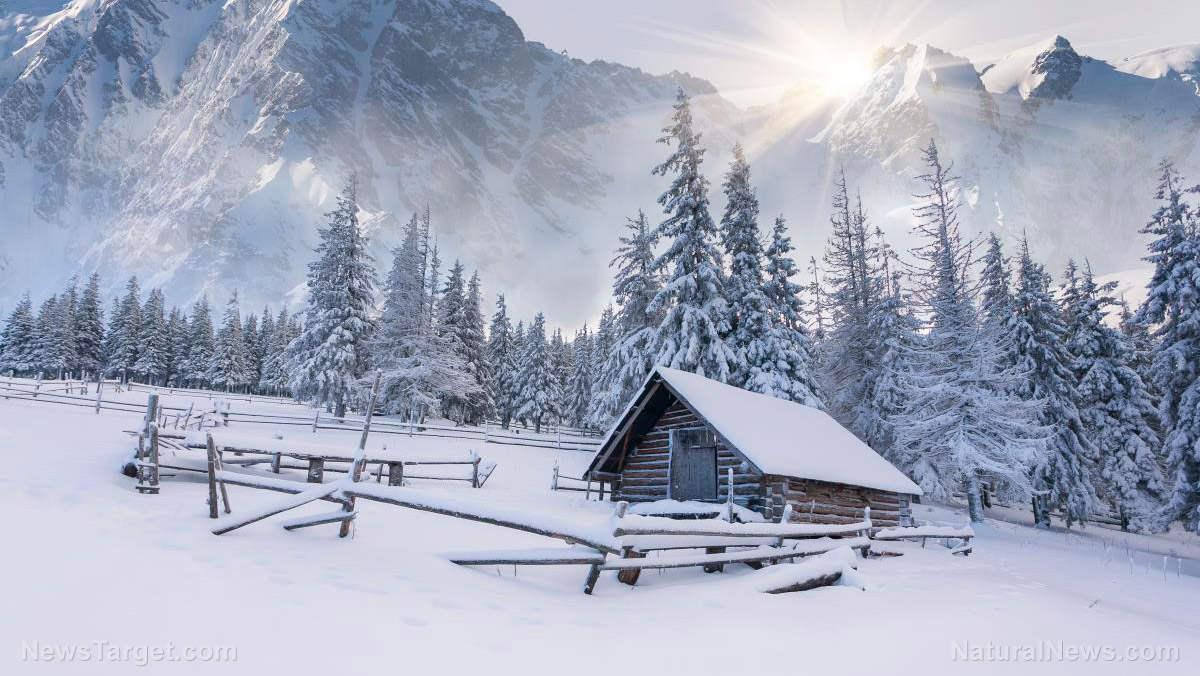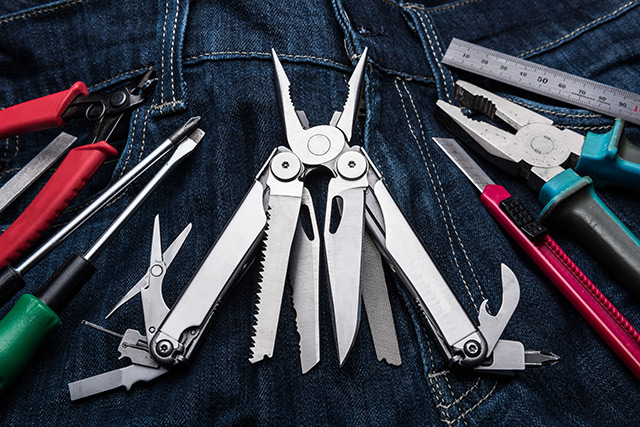 Parler
Parler Gab
Gab
Monitor the weather forecast and make the necessary preparations
Cold weather hazards can be unpredictable, but you should always stay informed and plan accordingly to ensure winter safety. Monitor the weather forecast for any winter weather advisory, like a winter storm warning or winter storm watch. This ensures that you can be prepared for whatever conditions may arise. (Related: Prepper must-haves: What to stock up on before a summer or winter power outage.)Limit time outdoors in extremely cold weather
Stay inside where it's warm and limit your time outdoors in extremely cold conditions. Prolonged exposure to cold temperatures during a winter storm can cause frostbite, which is when your skin and tissue freeze. Symptoms of frostbite include:- Numbness
- Tingling
- Red or pale skin
Winterize your home
Winter covers the landscape with beautiful snow, but it also brings with it colder temperatures and the potential for dangerous weather conditions. This is why you need to winterize your home before the coldest months set in. Taking a few simple steps can help ensure that your home is safe and comfortable throughout the winter.- Check if your heating system is in good working condition. Have it serviced by a professional if necessary, and keep any flammable materials away from heat sources.
- Insulate your home, especially doors and windows, against the cold.
- Stock up on winter supplies like food, water and warm clothing for the whole family.
Stay warm indoors
When the temperatures start to drop, it's best to stay warm indoors, like with a space heater. Space heaters can help to raise the temperature in a room and make it more comfortable, but you must know how to use them safely. Place the space heater on a level surface away from any flammable materials. Keep the doors and windows closed to help prevent heat from escaping. When the weather is cold, you can also stay warm in winter by wearing several layers of clothing. The layers help trap heat and help keep you warm.Follow a balanced diet
You need to make sure you're getting the proper nutrition to stay healthy as winter approaches. When it's cold, your body need's more energy to stay warm. This means you need to consume more calories. But eating in winter is not just about eating more food. You also need to make sure that you are getting the right mix of nutrients to keep your body functioning properly in cold conditions.Don't use a stovetop or oven for heating
You may need to consider alternative ways to heat your home during winter. However, using a stovetop or oven to heat your home can be extremely dangerous. Open flames from a stovetop or oven can easily ignite flammable materials nearby, which can cause a house fire. Leaving the oven door open while it's on can also result in deadly carbon monoxide (CO) poisoning. Using a stovetop or oven to heat your home can also put unnecessary strain on your home's electrical system, leading to power outages and other problems. To ensure your safety when SHTF, use safer methods to heat your home like a space heater.Keep the air moist
The dry air from indoor forced heating may cause congestion and less restful sleep. Prevent this by drinking enough water and clear liquids during the day to stay hydrated. You can also use a humidifier at night if you wake up feeling uncomfortable and have a little trouble breathing properlyGet a neti pot
Use a neti pot to keep your sinuses clean and open. Neti pots can help flush your nasal passages before bedtime. Used correctly, a neti pot can help you get a good night's sleep without congestion.Locate and mark your mainline water valve
Before SHTF, find out where your main water line valve is. Once you locate it, make sure that your mainline valve is working properly by locating and marking it. This ensures that you can quickly turn off the water if a pipe bursts or if there are other problems with supply lines in your home.Drain exterior pipes
Before the winter season approaches, drain exterior pipes because water left in these pipes can freeze and make the pipes burst. This can result in costly repairs and the loss of running water. Frozen pipes can also cause flooding if they thaw and the water is unable to drain properly.Insulate pipes
Insulate your pipes to help prevent them from freezing and bursting, which can lead to costly repairs. Wrapping your pipes in insulation means you can keep your water flowing freely even when the temperature gets colder.Bundle up if you have to go outside in cold weather
When it’s cold outside, make sure you're properly bundled up in warm clothing before you go outdoors. Wear several layers of clothing to protect yourself from the cold. Stay warm by putting on outerwear items like a coat and gloves in inclement weather.Check on the elderly
The elderly are especially vulnerable during severe winter weather since they are at increased risk from weather-related events like falls, hypothermia and frostbite. Many seniors often live alone and may not have anyone to check in on them during a winter storm. Help them stay safe by checking on elderly relatives and neighbors during winter storms.Shovel snow safely to avoid injuries
Snow and ice are some of the most common hazards in cold weather Stay safe while shoveling snow by following the tips below:- Warm up with some light exercises before shoveling snow.
- Use a shovel that's comfortable for you.
- Push the snow rather than lift it. Take frequent breaks and rest.
- Don't twist your body when throwing snow. This can cause back strain.
- Listen to your body and don't overdo it. If you feel pain, it's all right to rest.
Walk carefully on icy sidewalks and driveways
Be wary of ice on sidewalks and driveways in winter. The sidewalk can be very slippery and dangerous, making it easy to fall and hurt yourself. Ice can damage sidewalks and driveways. If you spot any ice build up on your property, take steps to remove it as soon as possible.Check your car before driving in severe winter weather
Severe winter weather can be tough on cars. Cold temperatures can cause battery failure and tire pressure changes. The cold can also make it hard to start your engine. Winter weather can also affect visibility due to snow and ice buildup on your windshield, so always check your car before driving in winter weather. Before you head out, take a couple of minutes to clear the snow and ice from your car. Also, check the roof so large chunks of snow don’t fly off while you are driving. Additionally, check your tire pressure and battery life before going on a winter drive to avoid potential breakdowns.Drive carefully in winter weather
Winter and icy weather can be unpredictable and dangerous, so take extra care when driving in winter conditions. Slippery roads and reduced visibility can make it difficult to control your vehicle so drive slowly and carefully to avoid any accidents.Consider changing to snow tires
Winter weather is a major factor in thousands of accidents annually since snow and ice can make it difficult to stop, turn and accelerate. Fortunately, you can improve your winter safety by changing to snow tires. Snow tires are specifically designed to provide better traction in cold weather, and they can help you maintain control of your vehicle if road conditions aren't ideal.Keep a winter emergency kit in your car
Make sure you have a winter emergency kit in your car so that when you get stranded on the road, you have access to important supplies like food, water and repair tools. Include the following items in your car winter emergency kit:- Durable backpack for storage
- A flashlight
- Extra batteries
- A first aid kit
- A blanket
- Snacks
- Water
- Jumper cables
- Battery-powered jump starter
- Roadside flares/glowsticks
- Flat tires inflation canister (non-explosive)
- Spare tire and jack
- Spare car fuses
- Small, foldable shovel
- Car escape tool with a seat belt cutter and window breaker
Never leave children or pets alone in cars in cold weather
As winter sets in, you need to be extra careful with children and pets to avoid accidents. Here are some risks linked to leaving kids and pets in cars during winter:- They can develop hypothermia if the car is not properly heated.
- They can be injured by carbon monoxide poisoning if the car is left running.
Stay hydrated
Hydration is important during warm weather, but did you know that it's also crucial in cold weather? Staying hydrated ensures that your body gets enough water in cold weather. Dehydration can make you more susceptible to colds and other illnesses. Additionally, staying hydrated helps keep your body functioning properly and your immune system strong.Learn how to spot the signs of frostbite and hypothermia
Before SHTF, learn about the dangers posed by cold weather. Frostbite and hypothermia are both serious conditions that can occur when someone is exposed to extreme cold. It is crucial to know the signs and symptoms of each. Frostbite occurs when your skin and tissues freeze, and it can lead to permanent damage. Frostbite symptoms include numbness, tingling and white or grayish-yellow skin. Hypothermia occurs when your body temperature drops below 95 F. Symptoms include confusion, drowsiness, shivering and slurred speech. If you suspect that someone has frostbite or hypothermia, seek medical help immediately. Winterize your home before SHTF so you can avoid common injuries and health issues. Watch the video below for tips on the best winter gear. This video is from the man-made survival channel on Brighteon.com.More related stories:
Prepping must-haves: Medical supplies and first aid kits. How to prepare your survival garden for winter. Intermediate prepping: What do you do once you’ve covered the basics? Sources include: Mind4Survival.com BugOutBagAcademy.com Brighteon.comNatural healing: The medicinal benefits of cayenne pepper
By Zoey Sky // Share
NEADA: US home heating bills to rise 17% year-over-year this winter
By Kevin Hughes // Share
Always prepped and ready: 100+ Useful items for your car’s glove compartment
By Zoey Sky // Share
European telecommunications networks may go offline this winter due to energy crisis
By Ethan Huff // Share
Governments continue to obscure COVID-19 vaccine data amid rising concerns over excess deaths
By patricklewis // Share
Tech giant Microsoft backs EXTINCTION with its support of carbon capture programs
By ramontomeydw // Share
Germany to resume arms exports to Israel despite repeated ceasefire violations
By isabelle // Share










